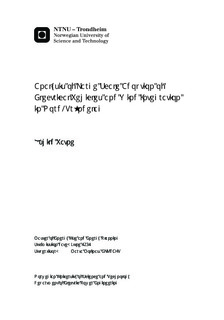| dc.description.abstract | With the Agreement on Climate Policy (Klimaforliket) signed by the Norwegian government on January 17th 2008, Norway has set a goal to reduce emission caused by transportation with 2.5 4 million tons CO2 equivalents compared with the reference for 2020. To reach this goal, high penetration of electrical vehicles is essential, and new technologies and solutions for the infrastructure must be cleared early in the process. With the aim of triggering a discussion on the topic, this thesis presents a methodology for analysing the impact of large-scale adoption of EVs on the electrical grid. A specific portion of a real network was selected and two charging modalities for the electrical vehicles were investigated. The analysis will focus mainly on chargers located at residences, to then explore how the utility can put forward a system for smart charging strategies ("dumb" vs. "smart" charging). Data from a low voltage network was provided by NTE, located in Steinkjer in Nord-Trøndelag. Three different scenarios were analysed. Scenario 1 was given as the base scenario, were the share of EVs where 0%. This was simulated to get a proper comparison. In scenario 2, a share of 10% EVs was implemented in the grid. The share of EVs in scenario 3 was decided to be 60%. The result obtained in the analysis, verified that the smart charging approach causes less strain on the gird. The low voltage network was not capable to handle a large share of EVs (>60%) without any charging scheduling. The smart charge strategy did not cause any extra strain at the grid during peak hours. In addition, the smart charging can introduce the Vehicle-to-Home solution. The EVs can provide ancillary service and support the network with matching supply/demand and reactive power support. A simplified analysis of V2H and reactive compensation was carried out to demonstrate how the grid could benefit from an implementation of EVs.The second part of the analysis, a series of wind measurement was included into the simulation in order to see if wind power can supply the load of the entire residential area. A design for suitable energy storage was also proposed in order for the system to operate as a stand-alone system. Grid stability and power quality was not included in the analysis. The result from the wind integration shows that in order for the network to operate as a stand-alone system in the worst-case scenario, there is a need of an enormous storage. It is assumed based on the results, that the system is self-supplied most part of the year. This thesis proposes a storage consisting of 7 battery-packs from old vehicles, with the capacity of 50 kWh each. This will result in a 30% reduction of the peak demand from the grid, when wind power is integrated.The case study addressed in the thesis, present a methodology for analysis the impact of a large adoption of EVs on the distribution network. The results obtained from this analysis, is considered transferable to similar networks. In order to achieve smart charging, there is need for further research on scheduling algorithms. | nb_NO |

